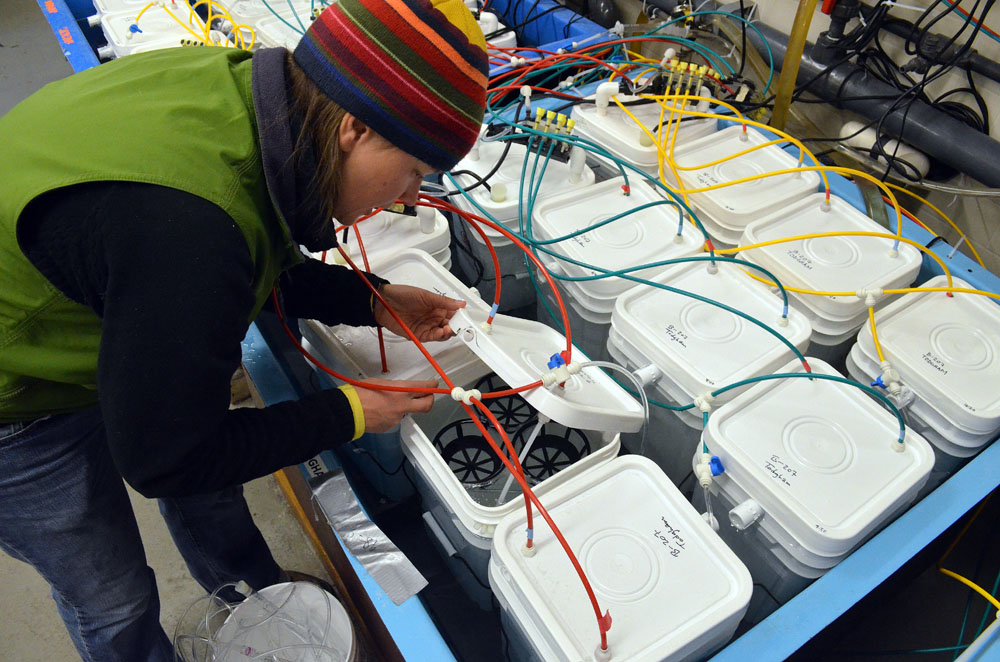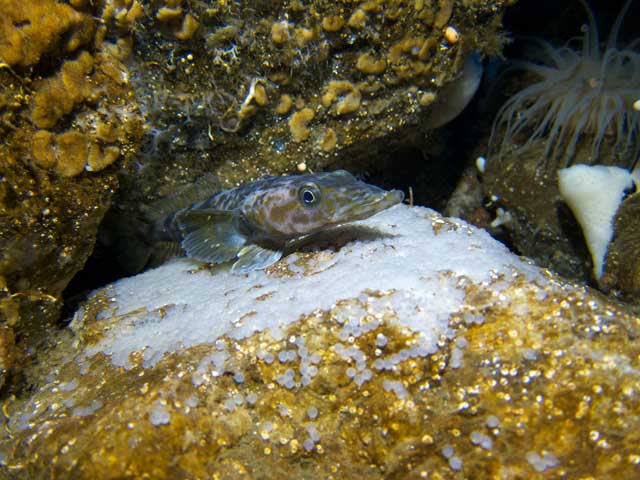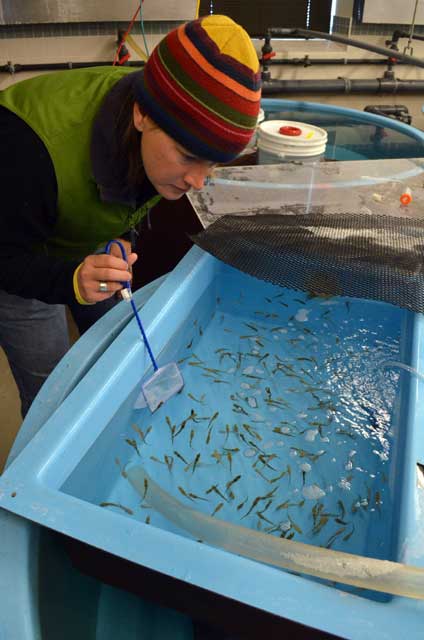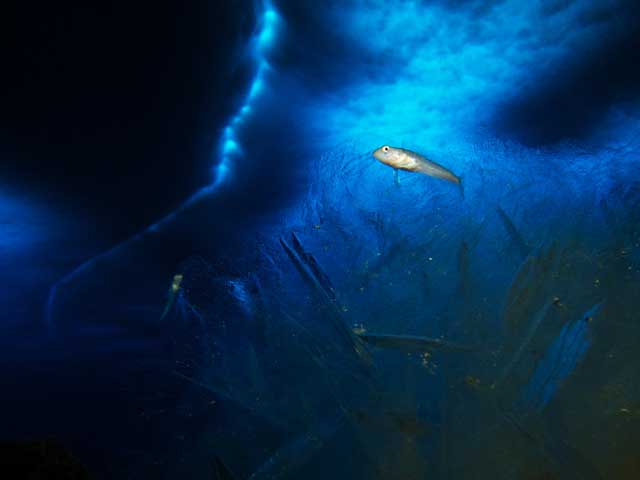|
Fast changesScientists test responses of fish in early life stages to acidifying, warming oceansPosted January 17, 2014
Thin, brightly colored tubes snake in and out of square-shaped plastic buckets that sit in three aquariums in the lowest level of McMurdo Station’s Crary Science and Engineering Center A closer look reveals what appear to be translucent Mentos, though these aren’t candy (except maybe to marine predators), but the eggs of Antarctic dragonfish (Gymnodraco acuticeps). Todgham isn’t waiting for the eggs to hatch – that would be about 10 months from now – but to understand how the ocean of the 22nd century may affect development of life at its earliest stages. Climate change will most certainly increase the temperature of seawater in the coming century. It will also change the pH, turning the water more acidic as ever increasing concentrations of carbon dioxide are absorbed into the ocean. Scratch the future tense: Such changes are already happening, particularly in the polar regions. That’s partly because gases like carbon dioxide and oxygen more readily dissolve in colder waters. In addition, waters at higher latitudes are also under saturated in the carbonate ion crucial to calcifying organisms that build shells, such as corals and sea urchins, and as ocean pH falls, so does the concentration of the carbonate ion. “We’re really interested in learning how vulnerable, or stress tolerant, are the species down here to changes in temperature, to changes in CO2,” explained Todgham, an assistant professor at San Francisco State University That explains the eggs and the tubes, which are bubbling in various concentrations of carbon dioxide, or CO2, into each container. One aquarium contains seawater at a temperature of about minus 1 degree Celsius. The other sits at about 2 degrees Celsius. The dragonfish and many of the 300 other species of fish in the Southern Ocean feel right at home at about minus 1.9 degrees Celsius. In the third aquarium are juvenile fish, mainly of a species called emerald rockcod (Trematomus bernacchii), part of the suborder Notothenioidei that dominate in the sub-freezing waters around Antarctica thanks to their unusual cold adaptations, such as a so-called antifreeze protein that prevents ice crystals from forming in their blood. This year Todgham is only hitting the juvenile fish, about the size of skinny minnows, with various combinations of CO2 rather than the double whammy of higher temperature and more acidic conditions the dragonfish eggs are getting. In the second year of the National Science Foundation “We can get a whole organismal perspective of how they’re doing. Our hope is to look at different species. Some may be better at [adapting to changes] than others,” Todgham said. “These fish are important food sources for seals, penguins and the big Mawsoni [Antarctic toothfish]. If we see shifts in food sources – and some are more nutritionally important than others – that can have a cascading effect through the [food web] system.” Fish don’t face the same threats as calcifying organisms, whose shells could literally dissolve as ocean pH drops. In fact, until recently, scientist believed fish would be largely unaffected by ocean acidification based on initial studies. “They should be really good at dealing with these subtle shifts of pH balance that we’re seeing with ocean acidification,” Todgham said. However, recent research has found that altering ocean pH can actually change fish behavior. For example, research led by Philip L. Munday at James Cook University Other studies have shown that fish larvae hatched from eggs that were exposed to high levels of CO2 were even deformed, with crooked spines, and had measurable changes in growth and oxygen consumption, according to Todgham. “We’re seeing these interesting things going on at the metabolic level that I don’t think we would have predicted based on the early work,” she said. Todgham’s own work is just beginning, though the U.S. government shutdown in October threatened to end it altogether this year. She and her team of graduate students and post-docs had only just arrived at McMurdo Station when they were turned around back to Christchurch, New Zealand, where they remained in a sort of exile until the National Science Foundation received the funding to restart the U.S. Antarctic Program (USAP) The late start meant the scope of the experiments had to be scaled back. USAP divers Rob Robbins, Steve Rupp and Martin Schuster collected what species they could find under the ice in McMurdo Sound. “The divers were instrumental this season. They collected all of the fish we are working on,” Todgham said. The system to mix the gases and set up the experiment also took time. One set of the plastic buckets in each aquarium bubbles at current CO2 concentrations in the Southern Ocean, about 420 parts per million, which is slightly higher than the rest of the world. Others contain water with future CO2 concentrations for the end of the century predicted by global models. Best case? About 650 ppm. Worst case? Maybe 1050 ppm. “This problem is unlike anything this species has seen for thousands and thousands of generations,” Todgham said. “The rate of change is one hundred times faster than anything that has been experienced in the past. Can biology keep up with the changes that are predicted?” NSF-funded research in this article: Anne Todgham, San Francisco State University, Award No. 1142122 |



For USAP Participants |
For The Public |
For Researchers and EducatorsContact UsU.S. National Science FoundationOffice of Polar Programs Geosciences Directorate 2415 Eisenhower Avenue, Suite W7100 Alexandria, VA 22314 Sign up for the NSF Office of Polar Programs newsletter and events. Feedback Form |







